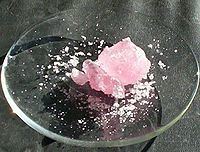Formula MnCl2 Density 2.98 g/cm³ Boiling point 1,225 °C | Molar mass 125.844 g/mol Melting point 654 °C Appearance pink solid (tetrahydrate) | |
 | ||
Related compounds | ||
Make manganese ii chloride from manganese metal
Manganese(II) chloride describes a series of compounds with the formula MnCl2(H2O)x, where the value of x can be 0, 2, or 4. The tetrahydrate is the most common form of "manganese(II) chloride" and is the tetrahydrate with the formula MnCl2·4H2O. The anhydrous form and a dihydrate MnCl2·2H2O are also known. Like many Mn(II) species, these salts are pink, with the paleness of the color being characteristic of transition metal complexes with high spin d5 configurations.
Contents
- Make manganese ii chloride from manganese metal
- Synthesis of manganese ii chloride
- Preparation
- Structures
- Chemical properties
- NMR
- Applications
- Precautions
- References
Synthesis of manganese ii chloride
Preparation
Manganese chloride is produced by treating manganese(IV) oxide with concentrated hydrochloric acid.
MnO2 + 4 HCl → MnCl2 + 2 H2O + Cl2This reaction was once used for the manufacture of chlorine. By carefully neutralizing the resulting solution with MnCO3, one can selectively precipitate iron salts, which are common impurities in manganese dioxide.
In the laboratory, manganese chloride can be prepared by treating manganese metal or manganese(II) carbonate and hydrochloric acid:
Mn + 2 HCl + 4 H2O → MnCl2(H2O)4 + H2MnCO3 + 2 HCl + 3 H2O → MnCl2(H2O)4 + CO2Structures
Anhydrous MnCl2 adopts a layered cadmium chloride-like structure. The tetrahydrate consists of octahedral cis-Mn(H2O)4Cl2 molecules. The trans isomer, which is metastable, is also known. The dihydrate MnCl2(H2O)2 is a coordination polymer. Each Mn center is coordinated to four doubly bridging chloride ligands. The octahedron is completed by a pair of mutually trans aquo ligands.
Chemical properties
The hydrates dissolve in water to give mildly acidic solutions with a pH of around 4. These solutions consist of the metal aquo complex [Mn(H2O)6]2+.
It is a weak Lewis acid, reacting with chloride ions to produce a series of solids containing the following ions [MnCl3]−, [MnCl4]2−, and [MnCl6]4−. Both [MnCl3]− and [MnCl4]2− are polymeric.
Upon treatment with typical organic ligands, manganese(II) undergoes oxidation by air to give Mn(III) complexes. Examples include [Mn(EDTA)]−, [Mn(CN)6]3−, and [Mn(acetylacetonate)3]. Triphenylphosphine forms a labile 2:1 adduct:
MnCl2 + 2 Ph3P → [MnCl2(Ph3P)2]Anhydrous manganese(II) chloride serves as a starting point for the synthesis of a variety of manganese compounds. For example, manganocene is prepared by reaction of MnCl2 with a solution of sodium cyclopentadienide in THF.
MnCl2 + 2 NaC5H5 → Mn(C5H5)2 + 2 NaClNMR
Aqueous solutions of manganese(II) chloride are used in 31P-NMR to determine the size and lamellarity of phospholipid vesicles. When manganese chloride is added to a vesicular solution, Mn2+ paramagnetic ions are released, perturbing the relaxation time of the phospholipids' phosphate groups and broadening the resulting 31P resonance signal. Only phospholipids located in the outermost monolayer exposed to Mn2+ experience this broadening. The effect is negligle for multilamellar vesicles, but for large unilamellar vesicles, a ~50% reduction in signal intensity is observed.
Applications
Manganese chloride is mainly used in the production of dry cell batteries. It is the precursor to the antiknock compound methylcyclopentadienyl manganese tricarbonyl.
Precautions
Manganism, or manganese poisoning, can be caused by long-term exposure to manganese dust or fumes.
